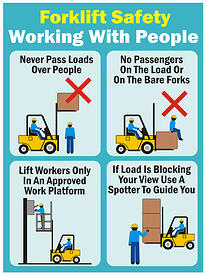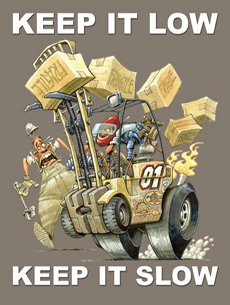Without further ado, here is the first scenario.
Scenario 1: Extension Deck Use
Taking a look at this picture, a few things come into mind. The chain & rope/webbing used could or could not be rated for the work load, the scissor lift isn't on the same horizontal platform as the trailer used for the wielding work, and of course, how can one be sure the trailer stays at an optimal horizontal level? One slip of the trailer forward and the beam is suspended and would most likely pull the lift over with it. That brings me to my most important point, using the extension deck as an overhead crane is not allowed by the manufacturer. The biggest hazard in a scissor lift is a tip over hazard and this type of use for a scissor lift creates a huge potential tip over hazard. As I said earlier, use the pictures here laterally across all makes and models. With that being said, I took the liberty to look up a few different scissor lift manuals and find out what their load limits are for the extension deck.
Genie GS-2632: Platform extended - Extension only 250 lbs or 113 kg
Skyjack SJIII 3215: Manual Extension Platform Capacity - 250 lbs or 113 kg
Skyjack SJIII 3219: Manual Extension Platform Capacity - 250 lbs or 113 kg
Skyjack SJIII 3220: Manual Extension Platform Capacity - 250 lbs or 113 kg
Skyjack SJIII 3226: Manual Extension Platform Capacity - 250 lbs or 113 kg
Skyjack SJIII 4620: Manual Extension Platform Capacity - 299 lbs or 136 kg
Skyjack SJIII 4626: Manual Extension Platform Capacity - 299 lbs or 136 kg
Skyjack SJIII 4632: Manual Extension Platform Capacity - 250 lbs or 113 kg
So the real question is if that steel beam is over 250 lbs.? I'd venture a guess and say that's correct with an almost certainty. This, again, creates a tip over hazard and thus, should be avoided. As a last note, these capacities are rated for a person and/or tools ON the extension deck, not hanging or fixed items attached to the deck. In fact, it clearly states in every one of these manuals that no objects should be attached (fixed or hanging) to any part of the machine.
Now onto the second scenario.
Scenario 2: Top Rail Use
This one is a bit more straight-forward, as many people seem to know that you are not supposed to use the top rail, specifically (as shown here) setting up a ladder on top of the top rail is quite dangerous. The stability of the machine is rated to a specific load weight and by climbing on or adding a ladder to the top rail you are creating more of a tip over hazard. Not to mention, there is a maximum side load force on that rail and by adding additional weight (as in a human or a ladder with a human) you can actually cause that rail to collapse under the weight and of course then a fall occurs. Since there is no fall protection necessary for a scissor lift, falling is not going to be a pleasant situation for anyone. Again, this one should be known to many, but unfortunately we see this scenario too often when an employee is trying to create an extra few feet (sometime inches) to reach whatever it is that they are working on. Frankly, if you can't reach what you are trying to work on with the scissor lift in question, you have two choices: either get a new lift (bigger scissor, boom lift, etc.) or don't do the job. Unfortunately, sometimes bosses don't want to hear this so you are caught in a predicament. Well, to help your protest, here is the citeable OSHA standard used to regulate such behavior:
"Employees shall always stand firmly on the floor of the basket, and shall not sit or climb on the edge of the basket or use planks, ladders, or other devices for a work position."
Now onto scenario three.
Scenario #3: Forklift Standing on Forks/Mast
Once again, this is generally for the reason I spoke of earlier, which is an additional few feet or so to the task at hand. Having someone ride the forks like an elevator may also be used because a company/ the individual doesn't have access to a proper machine such as a scissor lift or even better in many cases, a boom lift. Either that or they are some ignorant operators enjoying what they think is a toy in which case, that calls into question whether they were properly trained in the first place. For the purposes of this article, we will discuss the former. Seeing this picture, I understand very well what they were attempting to do. It would be a good assumption to say that they didn't have a way to get to those stage lights and so the idea they settled on was to ride the forks to the top of the mast. This is a huge hazard, and the way to avoid is simply to have the correct tools for the job. Seeing as this is outside, a rented boom lift would solve this problem quite easily. Another option would be to purchase or rent an attachment for their forklift that would allow a person to "ride" on the forks. This is usually a cage or platform made for such purposes. Certainly, just about any other option than having a person try to balance themselves 20+ feet in the air on the mast of a forklift!
Onto our final scenario.
Scenario #4: Ladders on Forklift Forks
This last picture/scenario is another one that I have seen posted a few times before. Going along with the previous scenario, where we learned (or reaffirmed) that standing on the mast or the forks without the proper attachment is dangerous and a fineable offense from OSHA, propping a ladder up on the forks is more of the same with regards to hazards and "don't do's." First off, there is a stability issue. Wind is a factor, unlevel ground is a factor, the forklift that you no longer control is a factor. In fact, that is ultimately what I want to point out here. As I said, much of what I talked about in the third scenario applies here, however I am able to talk about one additional important factoid related to forklifts and aerial lifts in general, and that is the control of the machine via the operator. One of the biggest reasons scissor lifts were created to begin with is because they allowed for the operator to both drive and elevate themselves without needing a second person. If you had a ladder on top of a truck or van, even if it was 100% stable, you still have to come back down to ground level to move your working platform (the ladder), not to mention the additional hazard of someone else (even if accidentally) can come and move the vehicle while you are suspended in mid-air! These hazards were mitigated by the use of scissor lifts, where we can go up, for example, and fix a light bulb and then while still elevated, we can drive to the next bulb and finish a row in minutes instead of an hour of up, down, drive, up, down, drive, etc. This scenario is harking back to the "old, dangerous days" of having no way of controlling the working platform while elevated. If that ladder gives, you're hurting. If the forklift moves, you're hurting. If the wind picks up, you're hurting. And with no fall protection required on a ladder, you can imagine what the outcome would look like. Again, the use of an industrial scissor lift (industrial because this picture takes place outside) would a great option, or again, a boom lift would suffice. With a boom lift, you could be relatively far away from roads, trees, power lines, etc. and simply extend the boom platform right up to where you need to work, and you have all the control in the moving of both your cage/working platform, and the driving of the machine is also in your hands.
Now, I understand that some of these options may set one back more time and/or money. But I assure you the cost of training yourself or your employees properly to use of these machines, or the cost of renting/buying one of these pieces of equipment or an additional lift is leagues below the cost of a settlement, the cost of a life, the cost of a lawsuit, the cost of an OSHA fine, and/or the cost of the worker's compensation paid out to the affected party. There are direct and indirect costs to these, whether you know it or not, that make these the more expensive options! The cost of a rental boom is nothing compared to the millions or even billions (depending on your company) in just indirect costs alone! These are what you don't think of when in the moment and tell an employee or think to yourself, "It'll only take a moment." That moment is all that is needed for an incident to occur and a terrible fate to potentially follow. If you agree, share this article and help promote a good, solid safety culture at your workplace. If you disagree, tell me below why and I will be sure to take some time and discuss your thoughts with you. Thank you for reading!

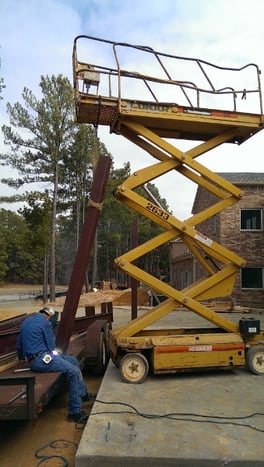
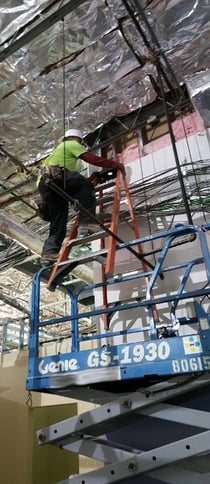
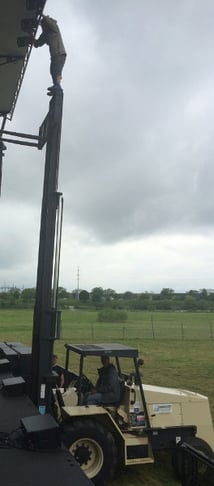
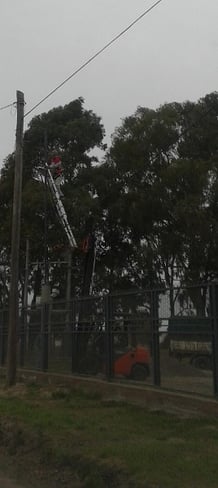

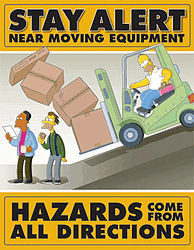 Establish speed limits
Establish speed limits